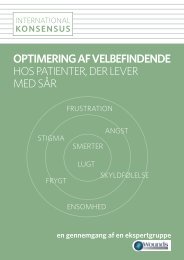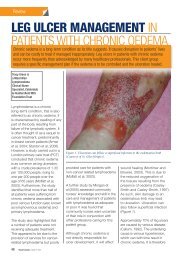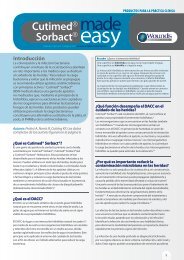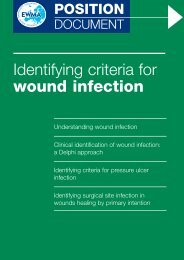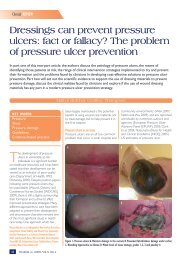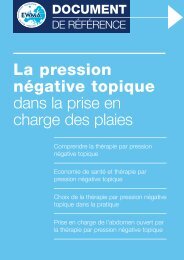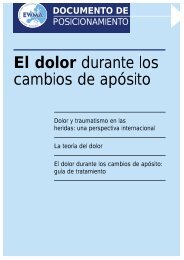VIEW PDF - Wounds UK
VIEW PDF - Wounds UK
VIEW PDF - Wounds UK
You also want an ePaper? Increase the reach of your titles
YUMPU automatically turns print PDFs into web optimized ePapers that Google loves.
Clinical PRACTICE DEVELOPMENTas there is the potential for diseasein the foot vessels to further bias theresults. The recommendation for allpressure measurement techniques is toplace the detector as close to the siteof vessel compression as is possible.Other potential problems that havebeen highlighted (Bianchi, 2005) withthe LOI technique include:8Thickened or trophic toe nails8Peripheral cyanosis8Digital vasospasm (Raynaud’sphenomenon)8Localised and well collateralisedperipheral vascular disease.A further disadvantage of usingthis technique from the patient’sperspective is that the ankle cuffremains inflated for a longer periodof time potentially causing increaseddiscomfort and pain. Anotherfundamental disadvantage is thatalthough the technique may give anindication of limb perfusion, it givesno information on the status of theindividual crural vessels.As with all techniques for measuringblood pressures, patient positioning isimportant if reliable and reproduciblereadings are to be obtained. Thecorrect cuff size and position mustbe selected but problems will stillarise due to abnormal limb size andnon-compressible vessels since theseare factors related to the cuff andcompression and not to the method ofblood flow detection.Equipment availability andmaintenance are also potentialproblems for both techniques, however,given the significant increase in theavailability of Doppler equipmentsince the RCN and SIGN guidelineswere published, accessibility should nolonger be a problem (Royal College ofNursing, 1998; Scottish IntercollegiateGuidelines Network, 1998).ConclusionLOI provides a method of monitoringpatients during treatment withcompression therapy but should notbe seen as a replacement for thehand-held continuous wave Dopplerand ABPI during the initial assessment16 <strong>Wounds</strong> <strong>UK</strong>, 2006,Vol 2, No 1of a patient with lower limb ulcerationor potential peripheral vasculardisease. Whichever method of arterialassessment is applied, and the authorswould continue to favour the use ofDoppler ABPI, it should, however, beremembered that the use of Dopplersupports the overall diagnostic andmanagement strategy. Results shouldnot be used in isolation but as partof the overall holistic patientassessment process. W<strong>UK</strong>LOI provides a methodof monitoring patientsduring treatment withcompression therapy butshould not be seen as areplacement for...Dopplerand ABPI during the initialassessment of a patientwith lower limb ulcerationor potential peripheralvascular disease.ReferencesBianchi J (2005) LOI: an alternative toDoppler in leg ulcer patients. <strong>Wounds</strong> <strong>UK</strong>1(1): 80–5Bianchi J, Douglas S (2002) Pulse oximetryvascular assessment in patients with legulcers. Br J Community Nurs 7 (9 Suppl): 22–8Bianchi J, Douglas WS, Dawe RS et al (2000)Pulse oximetry: a new tool to assess patientswith leg ulcers. J Wound Care 9(3): 109–12Carser DG (2001) Do we need to reappraiseour method of interpreting the ankle brachialpressure index? J Wound Care 10: 59–62Carter SA (1969) Clinical measurementof systolic pressures in limbs with arterialocclusive disease. JAMA 207(10): 1869–74Carter SA (1993) Role of pressuremeasurement. In: Bernstein EF, ed. VascularDiagnosis. Mosby, St Louis, Missouri: 486–512Couse NF, Delaney, CP, Horgan PG et al(1994) Pulse oximetry in the diagnosis ofnon-critical peripheral vascular insufficiency. JR Soc Med 87(9): 511–2Fowkes FG, Housley E, Macintyre CC, PrescottRJ, Ruckley CV (1988) Variability of ankle andbrachial systolic pressures in the measurementof atherosclerotic peripheral arterial disease. JEpidemiol Comm Health 42(2): 128–33Hocken AG (1967) Measurement of bloodpressurein the leg. Lancet 1(7488): 466–8Jawahar D, Rachamalla HR, Rafalowski A,Ilkhani R, Bharathan T, Anandarao N (1997)Pulse oximetry in the evaluation of peripheralvascular disease. Angiology 48(8): 721–4Johansson KE, Marklund BR, Fowelin JH(2002) Evaluation of a new screening methodfor detecting peripheral arterial disease in aprimary health care population of patientswith diabetes mellitus. Diabet Med 19(4):307–10Joyce WP, Walsh K, Gough DB, Gorey TF,Fitzpatrick JM (1990) Pulse oximetry: a newnon-invasive assessment of peripheral arterialocclusive disease. Br J Surg 77(10): 1115–7Ogren M, Hedblad B, Jungquist G, Isacsson SO,Lindell SE, Janzon L (1993) Low ankle-brachialpressure index in 68-year-old men: prevalence,risk factors and prognosis. Results fromprospective population study ‘Men born in 1914’,Malmo, Sweden. Eur J Vasc Surg 7(5): 500–6Royal College of Nursing (1998) TheManagement of Patients with Venous Leg Ulcers.RCN Institute, YorkSatomura S (1957) Ultrasonic Doppler methodfor the inspection of cardiac function. J AcoustSoc Am 29: 1181–5Scottish Intercollegiate Guidelines Network(SIGN) (1998) The Care of Patients with ChronicLeg Ulcer. SIGN, EdinburghSumner DS (1989) Non-invasive assessmentof peripheral arterial occlusive disease. In:Rutherford KS, Saunders WB, eds. VascularSurgery. Vol 1. Mosby, Philadelphia: 61–111Vowden KR, Vowden P (2001) Doppler andthe ABPI: how good is our understanding? JWound Care 10(6): 197–202Vowden KR, Goulding V, Vowden P (1996)Hand-held Doppler assessment for peripheralarterial disease. J Wound Care 5: 125–8Winsor T (1950) Influence of arterial diseaseon the systolic pressure gradients of theextremities. Am J Med Sci 220: 117Yao ST (1970) Experience with the Dopplerultrasound flow velocity meter in peripheralvascular disease. In: Gillespie JA, ed. ModernTrends in Vascular Surgery 1. Butterworth,London: 281–309Yao ST, Hobbs JT, Irvine WT (1968) Pulseexamination by an ultrasonic method. Br Med J4(630): 555–7




